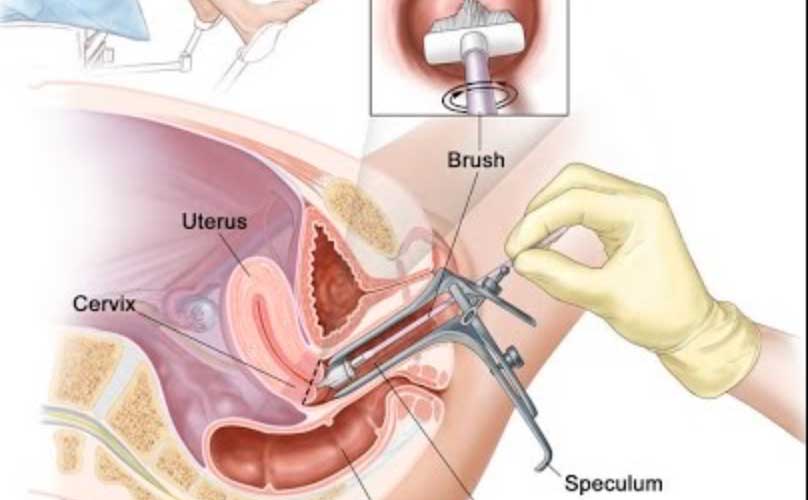
INFORMATION
Cone Biopsy
A cone biopsy (conization) is surgery to remove a sample of abnormal tissue from the cervix. The cervix is the lower part of the uterus (womb) that opens at the top of the vagina. Abnormal changes in the cells on the surface of the cervix is called cervical dysplasia.
How the Test is Performed
This procedure is done in the hospital or in a surgery center. You will be placed under general anesthesia (asleep and pain-free), or you will be given medicines to help you relax and feel sleepy.
A small cone-shaped sample of tissue is removed from the cervix. The procedure may be performed using a wire loop heated by electrical current (LEEP procedure), a scalpel (cold knife biopsy), or a laser beam.
The sample is examined under a microscope for signs of cancer. This biopsy may also be a treatment if the provider removes all of the diseased tissue.
Most of the time, you will be able to go home the same day as the procedure.
How to Prepare for the Test
You may be asked to not eat or drink for 6 to 8 hours before the test.
How the Test will Feel
After the procedure, you may have some cramping or discomfort for about a week. For about 4 to 6 weeks avoid:
- Douching (douching should never be done)
- Sexual intercourse
- Using tampons
For 2 to 3 weeks after the procedure, you may have discharge that is:
- Bloody
- Heavy
- Yellow-colored
Why the Test is Performed
Cone biopsy is done to detect cervical cancer or early changes that lead to cancer. A cone biopsy is done if a test called colposcopy cannot find the cause of an abnormal Pap smear.
Cone biopsy may also be used to treat:
- Moderate to severe types of abnormal cell changes (called CIN II or CIN III)
- Very early stage cervical cancer (stage 0 or IA1)
Normal Results
A normal result means there are no precancerous or cancerous cells in the cervix.
What Abnormal Results Mean
Most often, abnormal results mean that there are precancerous or cancerous cells in the cervix. These changes are called cervical intraepithelial neoplasia (CIN). The changes are divided into 3 groups:
- CIN I — mild dysplasia
- CIN II — moderate to marked dysplasia
- CIN III — severe dysplasia to carcinoma in situ
Abnormal results may also be due to cervical cancer.
Risks
Risks of cone biopsy include:
- Bleeding
- Incompetent cervix (which may lead to premature delivery)
- Infection
- Scarring of the cervix (which may cause painful periods, premature delivery, and difficulty getting pregnant)
- Damage to the bladder or rectum
Cone biopsy may also make it hard for your provider to interpret abnormal Pap smear results in the future.
Caring for Yourself at Home
In the first 24 hours after your procedure:
- Drink 8 to 12 (8-ounce) glasses (2 to 3 quarts) of liquids.
- Eat well-balanced, healthy meals.
Use sanitary pads for vaginal discharge.
- The first 4 days after your procedure, you may have vaginal discharge that looks like a menstrual period. The amount varies for each woman.
- Over the next 2 to 3 weeks after your procedure, your vaginal discharge will become clear and watery and then will stop.
For 4 to 6 weeks after your procedure or until your doctor tells you your cervix is healed:
- Don’t put anything inside your vagina (such as tampons and douches) or have vaginal intercourse.
- Take showers instead of tub baths. Don’t soak in water (such as swimming pools, hot tubs, or tub baths).
- Don’t do any heavy housework (such as vacuuming, yard work, or carrying groceries or laundry).
- Don’t lift objects over 10 pounds (4.5 kilograms).
- Don’t do any strenuous exercise (such as running and aerobics).
Your next period may be late or may have a heavier blood flow than usual.
Call your doctor’s office to schedule a follow-up visit. This should be about 4 weeks after your procedure
Call Your Doctor if You Have:
- A temperature of 101° F (38.3° C) or higher
- Chills
- Blood clots or bleeding that’s heavier than your normal menstrual period
- Vaginal discharge that smells bad or has a very strong smell
- Pain that isn’t relieved by pain medications
- Any questions or concerns
How much bleeding is normal after cervical biopsy?
After the biopsy, you may have some bleeding for up to a week. You may have mild cramping, your vagina may feel sore, and you may have a dark discharge for 1 to 3 days.
How long does it take for your cervix to heal after a biopsy?
Be sure to take only recommended medicines. You may be told not to douche, use tampons, or have sex for 1 week after a biopsy, or for a period advised by your doctor. After a cone biopsy, you should not put anything into your vagina until your cervix has healed. This may take several weeks.
What was your first sign of cervical cancer?
Early warning signs of cervical cancer. When present, common symptoms of a tumor that develops in the cervix may include vaginal bleeding, including bleeding between periods, after sexual intercourse or post-menopausal bleeding; unusual vaginal discharge, which may be watery, pink or foul-smelling; and pelvic pain.
Are you put to sleep for a cone biopsy?
A cone biopsy is surgery to remove a cone-shaped piece of tissue from the cervix. … You may be asleep during the surgery, but it is usually done while you are awake. You will not feel pain, because your cervix and the area around it will be numb.
Does cervix grow back after Conization?
The removed tissue is then sent to the laboratory. The laboratory studies the tissue and makes sure the abnormal cells have been cut away. New tissue grows back in the cervix in four to six weeks.
Can you get pregnant after a cone biopsy?
After a cone biopsy there is a very small chance that the cervix can narrow. … The cervix might become so tightly closed that sperm can‘t get in. If this happened, youwouldn’t be able to get pregnant naturally. If you‘re having periods after a cone biopsy you have not got complete cervical stenosis.
This Links are provided for information only
The information provided herein should not be used during any medical emergency or for the diagnosis or treatment of any medical condition. A licensed physician should be consulted for diagnosis and treatment of any and all medical conditions. Call 911 for all medical emergencies.





